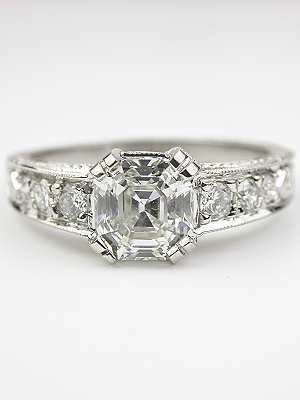The Hallmarks of Art Deco Engagement Rings
August 27, 2016When James Matthews recently asked for Pippa Middleton's hand in marriage, he proposed to the sister of Princess Kate with an engagement ring inspired by the Art Deco jewelry period. Now, having seen how stunning the ring looks on Pippa's finger, brides-to-be across the globe are focusing their attention on Art Deco engagement rings. What is drawing them to this century old jewelry tradition?
By all appearances, Pippa's engagement ring seems to feature a 4 carat Asscher cut diamond. Asscher diamonds are typically square with a step cutting that gives them unstoppable depth. Gazing into an Asscher diamond tantalizes the eye with a ripple effect akin to a pebble being skipped across crystalline water. On top of that, Pippa's engagement ring is surrounded by a hexagonal halo of accenting diamonds.

"New geometric shapes appeared during the Art Deco period, which spanned the years 1915 to 1935," explains Topazery's spokesperson. "So hexagonal settings like those in Pippa's engagement ring were extremely sought after. The baguette, trapeze, triangle, and half-moon cuts also soared in popularity during that timeframe, as did the Asscher cut."
With 28 facets, the Asscher cut diamond captures light from all directions and radiates unlike any other cut. "As a result, brides on a more limited budget than Pippa can feel like a princess with a diamond much smaller and more affordable than her 4 carat one," Topazery's spokesperson goes on to point out.
Asscher cut diamonds are known for their captivating optics and spellbinding beauty, no matter their size. The hexagonal settings that were part of the Art Deco era render the same optical illusion. Because they draw the eye outward, they make a small diamond appear much larger than it actually is.
Return to blog home
